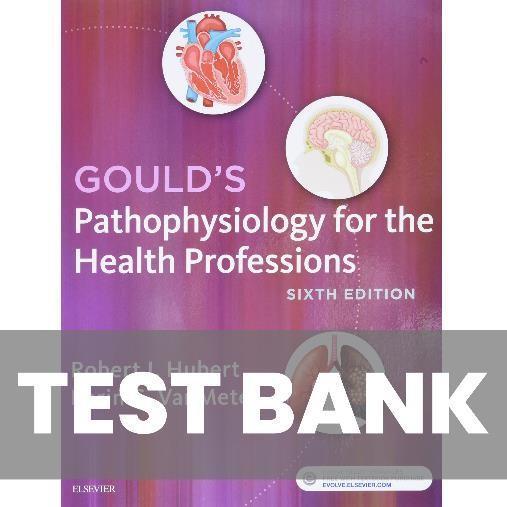Goulds Pathophysiology For The Health Professions 6th Edition Hubert TestBank

Chapter 01: IntroductiontoPathophysiology Test Bank
MULTIPLECHOICE
1. Which ofthe following would be the most likely cause ofan iatrogenic disease?
a. An inherited disorder
b. Acombination of specific etiological factors
c. An unwanted effect ofa prescribed drug
d. Prolonged exposure to toxic chemicals in the environment
ANS: C REF: 6
2. The manifestations ofa disease are best defined as the:
a. subjective feelings ofdiscomfort during a chronic illness.
b. signs and symptoms ofa disease.
c. factorsthat precipitate an acute episode ofa chronic illness.
d. early indicators ofthe prodromal stage of infection.
ANS: B REF: 6
3. The best definition ofthe term prognosis is the:
a. precipitating factors causing an acute episode.
b. Anumber of remissions to be expected during the course of a chronic illness.
Download All Chapters At : https://nursingrade.com/product/goulds-pathophysiology-for-the-health-professions-6thedition-hubert-test-bank/
c. predicted outcome or likelihood ofrecovery froma specific disease.
d. exacerbations occurring during chronic illness.
ANS: C REF: 7
4. Which ofthe following is considered a systemic sign ofdisease?
a. Swelling ofthe knee
b. Fever
c. Pain in the neck
d. Red rash on the face
ANS: B REF: 6
5. Etiology is defined as the studyofthe:
a. causes ofa disease.
b. courseofa disease.
c. expected complications ofa disease.
d. manifestations ofa disease.
ANS: A REF: 5
6. Atype of cellular adaptation in which there is a decrease in cell size is referred to as:
a. hypertrophy.
b. metaplasia.
c. anaplasia.
d. atrophy.
ANS: D REF: 8
7. A change ina tissue marked bycells that vary in size and shape and show increased mitotic figures would be called:
a. metaplasia.
b. atrophy.
c. dysplasia.
d. hypertrophy.
ANS: C REF: 8
8. Adeficit ofoxygen in the cells usually due to respiratoryor circulatoryproblems is called:
a. apoptosis.
b. ischemia.
c. hypertrophy.
d. necrosis.
Download All Chapters At : https://nursingrade.com/product/goulds-pathophysiology-for-the-health-professions-6thedition-hubert-test-bank/
ANS: B REF: 9
9. When a group ofcells in the bodydies, the change is called:
a. ischemia.
b. gangrene.
c. hypoxia.
d. necrosis.
ANS: D REF: 10
10. Rigorous weightlifting/bodybuilding regimens mayresult in the skeletal muscle cells undergoing:
a. hypertrophy.
b. dysplasia.
c. atrophy.
d. regeneration.
ANS: A REF: 8
11. The term cancer refers to:
a. dysplasia.
b. hyperplasia.
c. metaplasia.
d. malignant neoplasm.
ANS: D REF: 9
12. To which ofthe following does the term apoptosis refer?
a. Increased rateof mitosis bycertain cells
b. Ischemic damage to cells
c. Liquefaction ofnecrotic tissue
d. Preprogrammed cellself-destruction
ANS: D REF: 9
13. Which ofthe following statements is TRUE?
a. Alteration of DNAdoes not change cell function.
b. Damaged cells may be able to repair themselves
c. All types ofcells die at the same rate.
d. Mild ischemia causes immediate celldeath.
ANS: B REF: 10
14. Caseation necrosis refers to an area where:
a. cell proteins have been denatured.
b. cells are liquefied byenzymes.
c. dead cells forma thick cheesy substance.
d. bacterial invasion has occurred.
